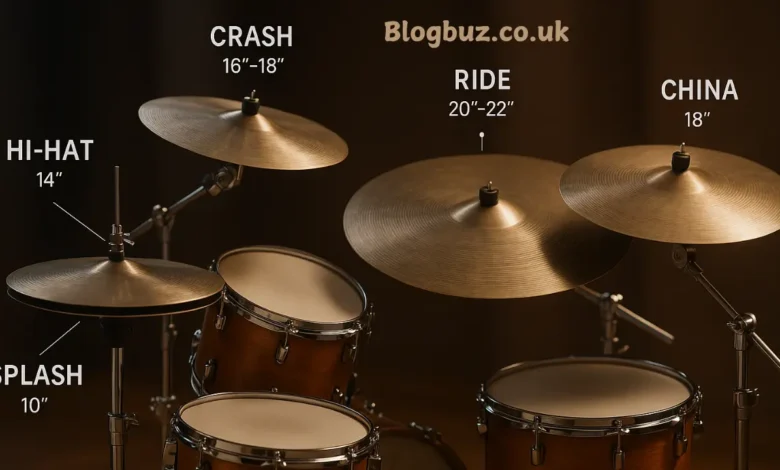Cymbals on Drum Set: A Complete Guide for Beginners and Enthusiasts

Cymbals are one of the most defining elements of a drum kit. They bring shimmer, accents, rhythm, and texture to music across genres. For beginners, understanding the role of cymbals on drum set setups can feel overwhelming. Still, with the proper knowledge, you can confidently identify, choose, and position cymbals to match your style. In this guide, we’ll explore the types of cymbals, their sizes, setup tips, and how to make the most out of your cymbal collection.
Introduction to Cymbals on Drum Set
When people think of drums, they often picture the bass drum, snare, and toms. However, cymbals play just as critical a role in shaping a drummer’s sound. Cymbals on drum set arrangements vary depending on the music style, but the essentials usually include hi-hats, a crash cymbal, and a ride cymbal. From there, drummers can expand their kit with splashes, chinas, or effects cymbals to create more dynamic tones.
Essential Cymbals on Drum Set
Not all cymbals are necessary for every drummer, but there are three essentials found in almost every standard kit:
Hi-Hat Cymbals
Hi-hats are a brace of cymbals mounted on a stand with a pedal that allows drummers to open and close them. They provide rhythmic patterns, timekeeping, and accents. Most hi-hats are 13–15 inches in size, with 14-inch hi-hats being the most common.
Crash Cymbals
Crash cymbals are designed for accents and dramatic moments in songs. Their explosive sound makes them perfect for punctuating transitions, choruses, or fills. Standard sizes range from 14 to 20 inches, with 16- and 18-inch crashes being the most versatile.
Ride Cymbals
The ride cymbal provides a steady, rhythmic pattern and is often used in place of the hi-hats in certain sections of a song. It produces a sustained “ping” sound and frequently has a bell area for sharper accents. Ride cymbals usually range from 19–24 inches, with 20–22 inches being the most popular.
Additional Cymbals on Drum Set
Once a drummer becomes comfortable with the basics, they often expand their setup to include extra cymbals for more tonal variety.
Splash Cymbals
Splash cymbals are small (6–12 inches) and produce a quick, sharp burst of sound. They are often used for accents in genres like funk, rock, and fusion.
China Cymbals
Chinese cymbals have an upturned edge and a trashy, exotic sound. They are commonly used for heavy accents in rock and metal music.
Effects Cymbals
Manufacturers also create cymbals with unique designs, such as those featuring holes or exceptional hammering. These add unusual sounds and textures for creative drummers.
Materials of Cymbals on Drum Set
Cymbals are typically made of bronze alloys, with B20 (80% copper, 20% tin) and B8 (92% copper, 8% tin) being the most common. Brass cymbals are suitable for beginners but are less durable and lack the tonal depth of their counterparts.
- B20 Alloy: Warm, complex, professional sound.
- B8 Alloy: Bright, cutting sound, popular in rock and pop.
- Brass: Affordable, but limited in tone and durability.
Choosing the right material depends on budget and desired sound.
Sizes and Their Impact
The size of cymbals on drum set arrangements significantly affects their sound:
- More miniature cymbals (hi-hats or splashes) produce quicker, higher-pitched sounds.
- Larger cymbals (rides or crashes) sustain longer and deliver deeper tones.
- Matching cymbal sizes to music style is essential—for example, jazz drummers often use more miniature, thinner cymbals, while rock drummers prefer larger, heavier ones.
Cymbal Placement and Setup
Proper placement of cymbals on drum set kits is crucial for comfort, efficiency, and preventing injury.
- Start with Hi-Hats: Place them slightly left of the snare (for right-handed drummers), at about elbow height.
- Add the Ride Cymbal: Position it on the right, angled slightly for comfortable reach.
- Crash Cymbals: Place above or slightly to the left/right of the toms for easy striking during fills.
- Extra Cymbals: Arrange splashes, chinas, or effects where they can be used without overreaching.
Keeping cymbals at a comfortable distance allows smoother transitions and reduces fatigue.
Choosing Cymbals for Beginners
For those just starting, investing in a cymbal pack can be more cost-effective than purchasing individual pieces. These packs usually include:
- A pair of hi-hats
- One crash cymbal
- One ride cymbal
Brands like Zildjian, Sabian, Meinl, and Paiste all offer beginner-friendly sets made of B8 alloy, which strike a balance between affordability and sound quality.
Caring for Cymbals on Drum Set
Cymbals are an investment, and taking care of them ensures they last for years:
- Proper Handling: Always pick up cymbals by the edge to avoid fingerprints.
- Cleaning: Use manufacturer-approved cleaners to maintain shine and tone.
- Storage: Keep cymbals in padded bags or cases when transporting.
- Mounting: Use cymbal felts and sleeves on stands to prevent keyholing or cracking.
Advanced Cymbal Choices
As drummers progress, they may expand their collection to suit their personal style. Jazz drummers may choose thin, dark cymbals for subtle tones, while metal drummers often prefer large, heavy cymbals for power and volume. Experimenting with stacking cymbals or combining different brands can create unique effects.
Common Questions About Cymbals on Drum Set
Q: How many cymbals does a standard drum set have?
A: Most standard sets include three: hi-hats, one crash, and one ride.
Q: Can I play drums with only one cymbal?
A: Yes, some minimalist drummers only use hi-hats or a single crash/ride, but having multiple cymbals adds more versatility.
Conclusion
Cymbals on drum set configurations are more than just accessories—they are essential tools that shape a drummer’s style and sound. From the crisp patterns of hi-hats to the explosive crash and steady ride, cymbals provide both rhythm and flair. Beginners should focus on mastering the three core cymbals, while more advanced drummers can experiment with splashes, chinas, and effects. With the proper knowledge of cymbal types, sizes, materials, and placement, every drummer can build a setup that complements their music perfectly.
You May Also Read: Instrument That Goes Rat A Tat Tat: Exploring the Iconic Sound of the Snare Drum




